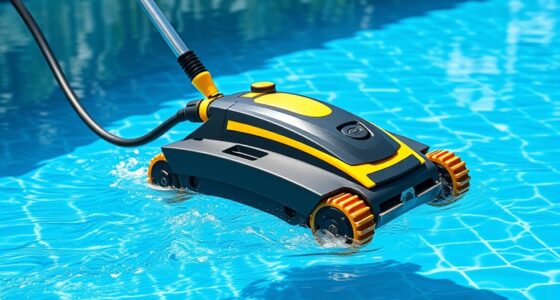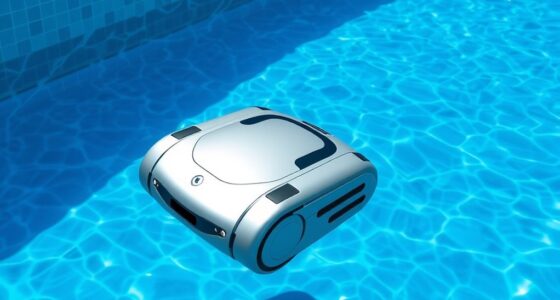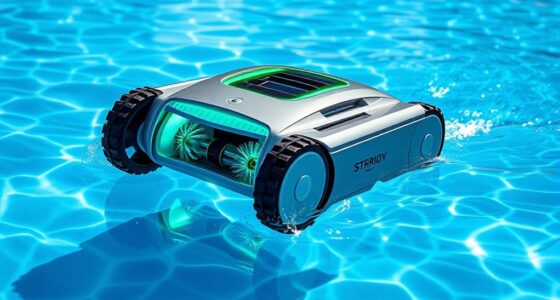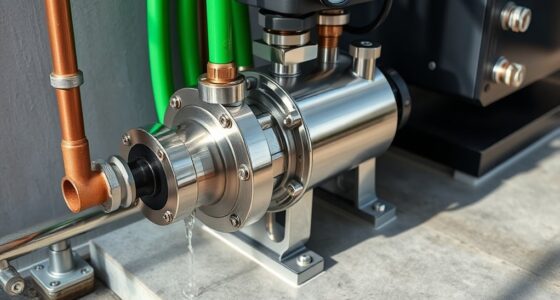An energy-efficient dishwasher uses advanced technologies like soil sensors, water filtration, and optimized spray arms to save water and electricity. It features energy labels that rate its efficiency, helping you choose models that reduce costs and environmental impact. Proper load and cycle selection, especially eco settings, maximize savings, while features like natural air drying or condenser drying lower energy use. Keep your machine maintained, and you’ll discover simple ways to enhance its performance and efficiency.
Key Takeaways
- An A-rated dishwasher uses less electricity and water, reducing both costs and environmental impact.
- Soil sensors and load detection adjust water and energy use based on dirt levels and load size.
- Eco and sensor-based cycles optimize resource use by adjusting cycle duration and water heating.
- Advanced drying technologies like zeolite or natural air drying minimize energy consumption during drying.
- Regular maintenance, such as cleaning filters and running full loads, ensures optimal efficiency and performance.
Understanding Energy Labels and Ratings
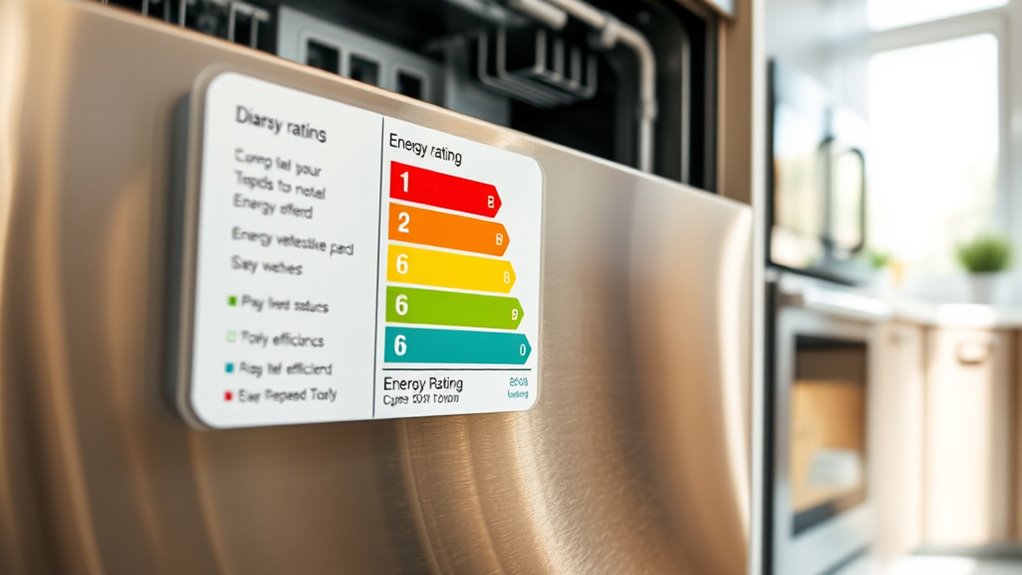
Have you ever wondered what those energy labels on dishwashers really mean? They use energy labels, like the EU energy label, with a color pyramid from green (A) to red (G), indicating energy efficiency. The rating considers multiple factors such as energy consumption, water use, cleaning, and drying performance, giving a clear efficiency rating. An A-rated dishwasher typically uses less electricity and water, cutting down your costs and environmental impact. The EnergyGuide label offers estimates of annual energy costs and consumption, helping you compare models quickly. Modern labels also focus on efficiency relative to capacity, so larger dishwashers may use more energy overall but still be efficient for their size. Understanding energy labels can help you make informed choices and find a model that fits your sustainability goals. These labels give you a complete picture of a dishwasher’s efficiency, including how the performance metrics are calculated to provide a comprehensive assessment. Additionally, considering AI-driven innovations in appliance technology can lead to even more energy-efficient options in the future. Incorporating personality test insights can also guide consumers toward selecting appliances that align with their eco-conscious values and personal preferences. Furthermore, understanding how energy ratings are determined can help you better interpret the labels and choose appliances that truly meet your efficiency standards.
Key Technologies That Improve Efficiency

Modern energy-efficient dishwashers incorporate a range of innovative technologies that considerably reduce resource consumption. These include soil sensors that detect dirt levels and adjust cycles accordingly, saving water and energy. Water filtration systems recirculate water, minimizing waste while maintaining cleaning power. Spray arms with optimized jets ensure even water distribution, reducing water and electricity use. Additionally, load sensors and variable cycle options tailor water and energy use to the load size and soil detection, preventing excess consumption. Advanced drying technologies like zeolite granules or natural air drying consume less energy compared to traditional heat drying. Incorporating industry trends ensures these appliances stay at the forefront of energy conservation. By integrating these features, an energy-efficient dishwasher delivers effective cleaning while substantially lowering resource use, making it better for your environment and your utility bills.
The Role of Load and Cycle Selection
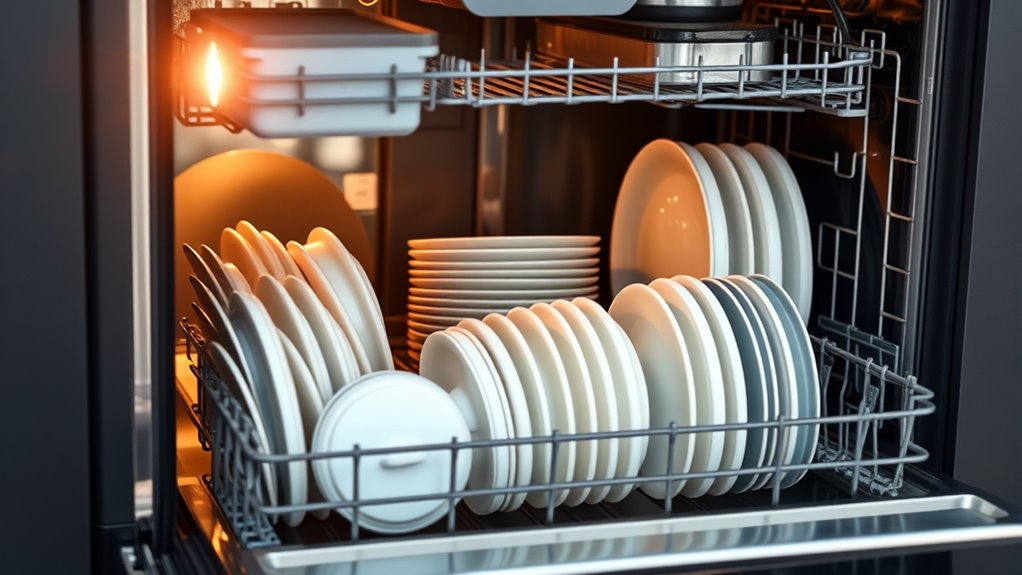
Choosing the right load size and cycle can substantially boost your dishwasher’s efficiency. Always load the dishwasher with full loads to maximize water and energy use per wash, reducing resource waste. Opt for eco cycles when possible, as they limit water heating and cycle duration, saving energy. Sensor-based programs automatically adjust water and energy based on soil levels, ensuring efficient cleaning without excess resource use. Proper cycle selection is key—shorter or eco cycles are ideal for lightly soiled dishes, while heavier cycles suit more soiled items. Avoid pre-rinsing dishes, as modern dishwashers detect soil levels and adjust accordingly. Additionally, selecting the appropriate cycle with efficient water use helps minimize waste and lowers utility bills. Incorporating technological innovations in dishwasher design can further enhance energy efficiency by optimizing cycle times and resource consumption. Staying informed about smart appliance features can help you make better choices for energy-saving operation. Using proper loading techniques ensures optimal water and detergent distribution, further reducing waste and improving cleaning performance. By loading the dishwasher correctly and choosing appropriate cycles, you’ll ensure thorough cleaning while minimizing water and energy consumption.
Effective Drying Methods for Saving Energy
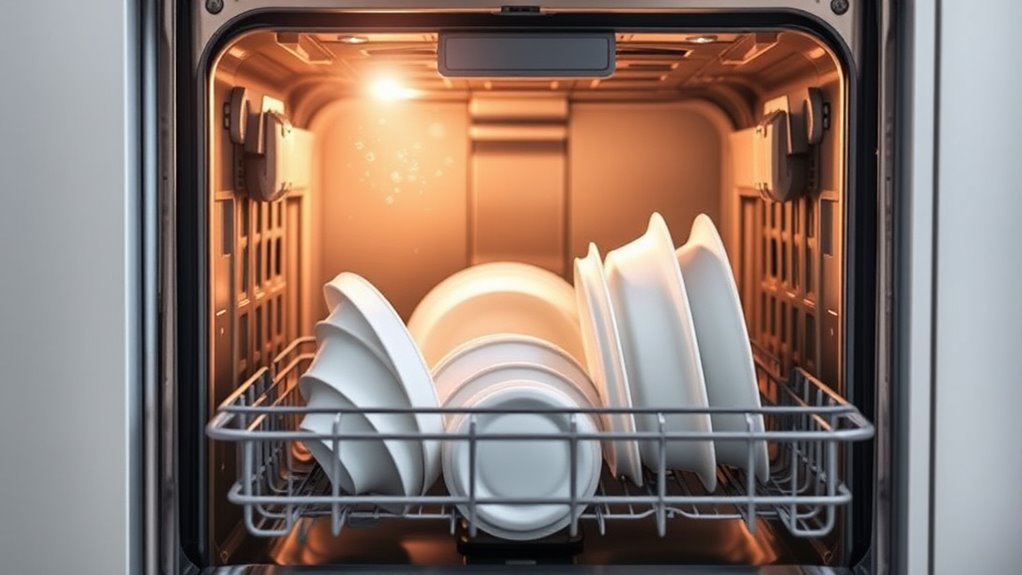
To save energy during the drying phase, you can opt for natural air drying methods instead of relying solely on heated dry cycles. Air-drying is an effective, energy-efficient approach that reduces utility bills and minimizes energy consumption. Consider these drying methods:
- Open the dishwasher door after the cycle to allow natural moisture absorption.
- Use dishwashers with condenser drying, which employs heat exchange to evaporate moisture more efficiently.
- Choose models with active drying features, like zeolite granules, that absorb moisture and release heat without extra energy.
- Avoid heat drying whenever possible, as it can cut energy use by up to 70%.
- Selecting energy-efficient appliances can further enhance overall savings and reduce your environmental impact.
- Incorporating energy-saving features in your dishwasher can optimize drying performance while conserving energy.
- Proper ventilation around your dishwasher can also improve drying efficiency by promoting better moisture evaporation.
Practical Tips for Maintaining Energy Efficiency
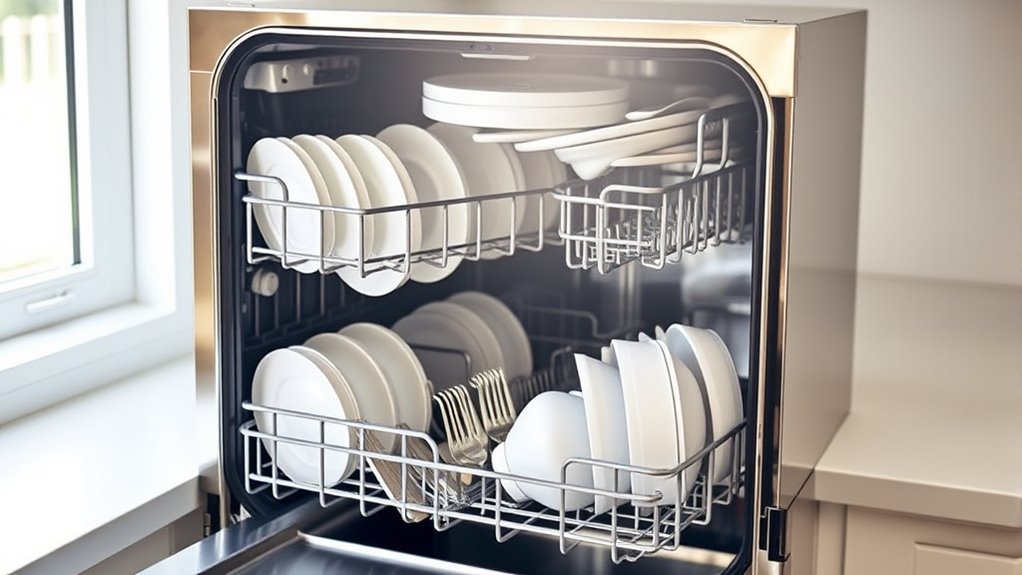
Maintaining your dishwasher’s energy efficiency requires regular attention and proper habits. Start by cleaning the filter and spray arms frequently to prevent clogs and guarantee ideal water flow, boosting performance. Always run full loads and select eco or energy-saving cycles to minimize water and energy costs. Avoid pre-rinsing dishes unnecessarily, as modern dishwashers handle food residues efficiently, saving resources. Keep the door seal clean and in good condition to prevent heat loss during drying, reducing energy use. Periodically run a cleaning cycle with a dishwasher cleaner to remove mineral buildup and maintain peak performance. These simple steps help your dishwasher operate efficiently, lower your energy costs, and extend its lifespan, ensuring it remains an eco-friendly appliance in your home. Additionally, regularly checking and maintaining other components can further enhance overall efficiency, similar to how effective filtration ensures optimal pump protection. Properly maintaining your dishwasher also involves understanding energy‑saving features, which can significantly improve its efficiency and reduce utility bills. Incorporating industry transformation insights can also inspire innovative ways to optimize appliance performance and sustainability. Regular maintenance of performance kits can further ensure your dishwasher functions at its best and conserves energy more effectively.
Frequently Asked Questions
What Makes a Dishwasher Energy-Efficient?
You can make your dishwasher energy-efficient by choosing an A-rated model, which uses less power and water. Use eco or auto cycles, and load it properly to maximize efficiency. Look for ENERGY STAR® certification, as these models cut water and energy use considerably. Also, avoid overloading and select the right cycle for your load, helping you save on utility bills while protecting the environment.
Is It Worth Getting an Energy-Efficient Dishwasher?
You might wonder if investing in an energy-efficient dishwasher is worth it. The answer is yes, because it saves you money, conserves water, and reduces energy use over time. You’ll benefit from lower utility bills, quicker cleaning with advanced features, and the satisfaction of helping the environment. While the upfront cost is higher, the long-term savings and eco-friendly impact make it a smart, worthwhile choice for your home.
Is It Cheaper to Wash Dishes by Hand or Run the Dishwasher?
You might think hand washing is cheaper, but it often isn’t. Running a dishwasher costs about $0.50 to $1.50 per load, while hand washing can use over 20 gallons of water and more energy if you’re not careful. An energy-efficient dishwasher uses less water and power, saving you money in the long run. Fully loading your dishwasher and using eco modes make it even more cost-effective compared to hand washing.
Is It Better to Run the Dishwasher on Quick Wash or Eco?
Imagine your dishwasher as a wise traveler choosing the best path. For lightly soiled dishes, running it on eco mode is like taking the scenic route—slower but more rewarding with savings. Quick wash is like a sprint—fast but uses more resources, especially if dishes are heavily soiled. For efficiency, opt for eco cycles when possible, saving around 30% in water and energy annually, and keep your journey sustainable.
Conclusion
So, next time you pick a dishwasher, don’t just go for the shiny new model—remember, those energy labels aren’t just decoration. With a little effort, you can save energy and money, but hey, if you’d rather spend more on your electric bill, that’s your call. Just don’t be surprised when your appliance’s “eco-friendly” claims turn out to be more “eco-somewhat-friendly.” After all, who needs efficiency when you can have convenience, right?


